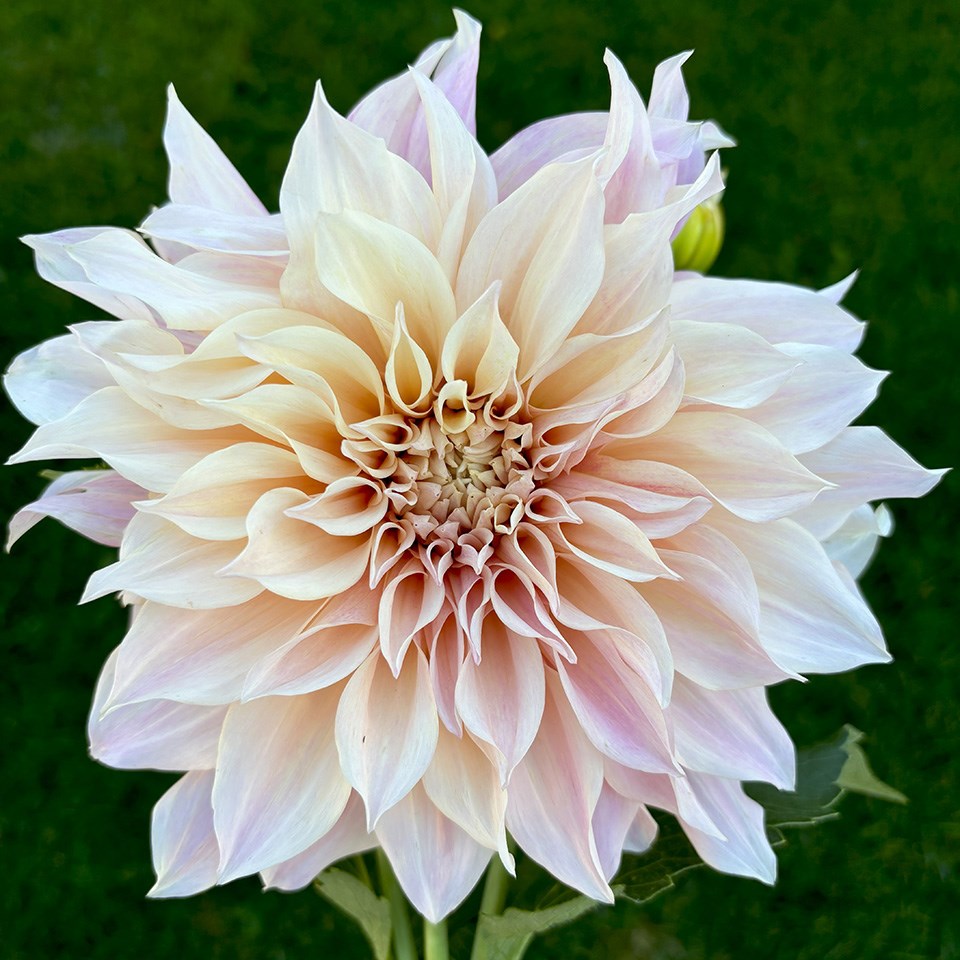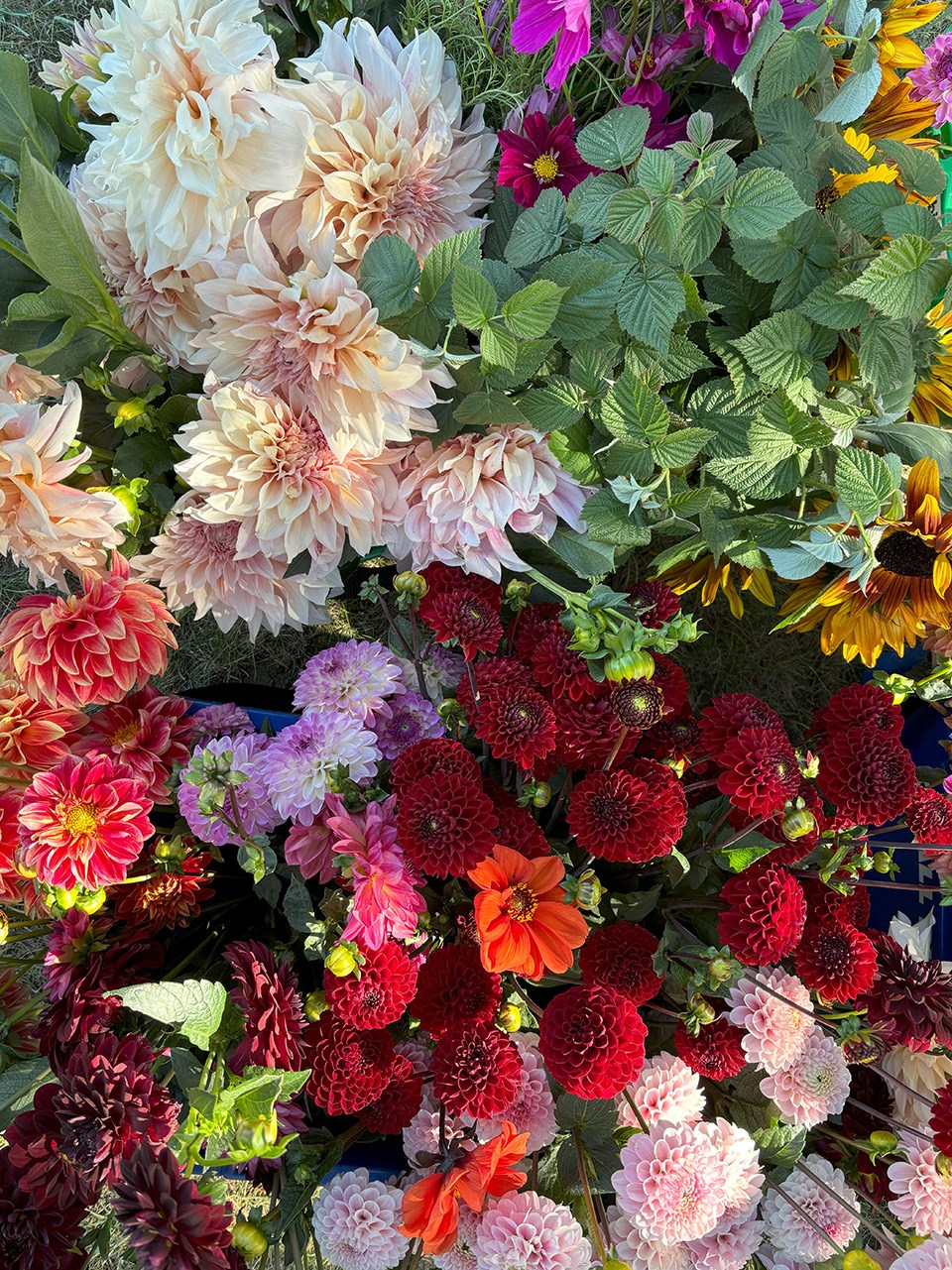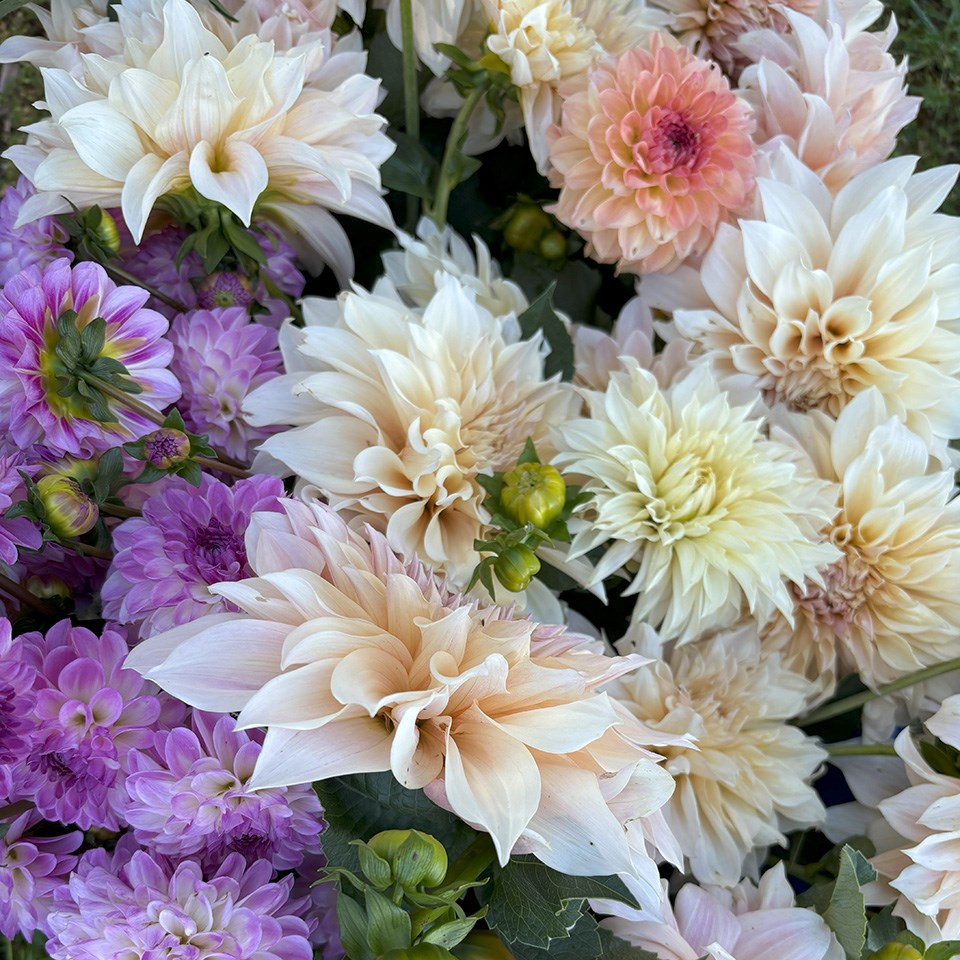What do intricate quilting patterns, stunning dahlia blooms, and a passion for gardening all have in common? For Shelly Wenger, owner of Sawtooth Farm, they intertwine beautifully in her mission to help others grow these vibrant flowers while inspiring them to follow their creative dreams.
What Are Dahlias?
Dahlias are tuberous perennials known for their vivid, mesmerizing blooms that range from the size of a button to dinner plates. Originating in Mexico and Central America, they are beloved for their wide range of colours, shapes, and sizes. With hundreds of varieties, dahlias offer something for every gardener.
But these beauties come with some challenges, especially if you live in colder climates like Alberta. Dahlia tubers can’t survive freezing temperatures, making proper winter storage essential.
Today, Shelly will guide us through her journey from hobbyist to a blooming business, and she shares her tips on how to grow dahlias and store the tubers over the winter.

Shelly’s Story
Shelly’s adventure started as a small backyard project and blossomed into a thriving operation with over 50 varieties and approximately 1,300 plants.
“I grew up on a family farm surrounded by vegetable gardens and flowers like peonies, irises, and roses. That passion for growing things stayed with me,” Shelly shares.
Her fascination with dahlias began in 2017 when she spotted their blooms on Instagram.
“I couldn’t believe how beautiful they were,” she recalls.
Starting with tubers from big-box stores, Shelly expanded her garden to her parents’ farm. Years later, she’s cultivated not only an extensive collection of dahlias but also invaluable knowledge in growing, propagating, and storing them.

The Secret to Storing Dahlia Tubers
For many gardeners, the winter season poses the biggest challenge when it comes to keeping dahlia tubers alive. Shelly emphasizes that the key to healthy tubers lies in proper storage conditions. Here are her tips for success:
Protect Them from Freezing Temperatures:
“Dahlias can’t survive our freezing winters,” Shelly explains. “The ground freezes, and so do the tubers if left unprotected.” Storing them in a shed or garage is also a no-go unless it’s heated and insulated.
Choose the Right Spot:
“The best place is a cool, dark, but not freezing area,” Shelly suggests. Options include a cold room, a closet in the basement, or a heated garage that stays around 6 to 7 degrees Celsius.
Use the Right Materials:
“I store my tubers in peat moss, but wood shavings work well too,” she adds. These materials help retain just enough moisture while keeping the tubers from drying out.
Beware of Sprouting:
If stored in a location that is too warm, the tubers will start sprouting too early. Keeping them in the right conditions ensures they stay dormant until planting season.

Why Dahlias Are a Gardener’s Dream
For Shelly, what makes dahlias truly special is their ability to reward your care with more blooms.
“They’re a cut-and-come-again flower,” she explains. “The more you pick, the more they bloom!”
Dahlias also offer incredible variety. Shelly’s favourites are the ball-shaped varieties in peach or coral tones.
“I have blooms as small as a toonie and as large as a dinner plate, in almost every colour imaginable,” she says.
Shelly advises planting dahlia tubers in well-draining soil around Mother’s Day, once the ground has warmed up.
“You can plant them as late as the end of June in our short growing season. While dahlias don’t start blooming until mid-August, their stunning display continues until the first frost.”
For beginners, her advice is simple: “Find the colour and variety that excites you! Whether it’s a search on Google, our website, or Instagram, there’s a perfect dahlia for everyone out there.”
Can Dahlias Be Dried?
While most enjoy fresh dahlias, Shelly notes that certain varieties can be dried, particularly those with a single ring of petals, like collarette dahlias. Larger varieties, such as the dinner-plate types, are best appreciated fresh due to their dense petals.
Little-Known Dahlia Facts
Dahlias were named after Swedish botanist Anders Dahl. They were originally grown for food, as their tubers are similar to potatoes! The largest dahlia blooms can span nearly 12 inches in diameter, making them true showstoppers in your garden. While stunning, dahlias can be toxic if your pets decide to nibble on them.
How Does Quilting Factor into All of This?
The Sawtooth Star quilt block, first named in 1884 in the Farm and Fireside Magazine, is a timeless design inspired by the triangular shapes resembling saw teeth. This versatile block has been known by various names, including Evening Star and Morning Star, reflecting its widespread use and cultural significance. Historically, stars held sacred meanings for Native Americans, symbolizing honour and protection, and were often incorporated into quilts gifted for special occasions like weddings or births.
Shelly explains, “When I made the leap to opening a business, I wanted a name that would draw on the homestead vibe and also my experiences as a homemaker, active community member, mother, and to help celebrate all that entails. Incorporating the name of my favourite quilt block, the Sawtooth Star, was a way to draw all those aspects together.”

Ready to Start Your Dahlia Journey?
If you’re ready to bring these incredible flowers into your garden, visit Sawtooth Farm online to explore their extensive collection of dahlia tubers. While only available during the spring for purchase, you can bookmark this page for inspiration or to get ready for next spring.
Looking for cut flowers? Sawtooth Farms has those too, ensuring you can enjoy flowers all summer long, whether you plant them or they arrive vase-ready.
Don’t wait to make these stunning flowers part of your garden now and for future seasons.
Nerissa McNaughton is a freelance writer and a contributor to Great West Media. This story was written for Great West Media's Hot Summer Guide advertising feature. The Hot Summer Guide is a special feature about summer activities, bucket list adventures, staycation options, road trips, attractions, events, and road trip-worthy food & beverage destinations across Alberta. It is not written by and does not necessarily reflect the views of the editorial staff.



